| MD LINKS: | PERFORMANCE CATALOGUE | MD MAIN PAGE |
Biography -- MICHAEL DUNN
|
from his press package, dated August 4th, 1964
|
|
Until now, Toulouse Lautrec and Barnum's celebrated "General Tom Thumb" (Charles S. Stratton), 19th Century contemporaries, were the last of the world's long line of little giants -- each in his own field a striking exponent of the dictum that acute intelligence and high courage are two of the compensating attributes of dwarfs. Dunn (real name Gary Neil Miller) was the dramatic prodigy of Broadway's 1963-‘64 season in "The Ballad of the Sad Cafe," which starred him with Colleen Dewhurst and Lou Antonio as the holder of the balance of power in a savage battle of the sexes. Previously he had been a hit on the nightclub circuit as a singer not capitalizing on his size. And he was the pride of Florida's University of Miami as editor of Tempo, which that year won the Sigma Delta Chi award as best college magazine in the country. As a child he was a prodigy of the piano, but had to abandon all hope of a concert career when the congenital and progressive chondrodystrophy, which afflicts him, crippled his elbows. Now 29, with blue eyes, light brown hair, a large head, and a body diminishing into very short legs, he was born of normal-size parents, Fred and Jewell Miller, in Shattuck, Oklahoma. His mother's maiden name was Dunn and he took it for professional purposes when he found that there was another actor named Gary Miller. When he was four, the family moved to Dearborn, Michigan where his father is now chief field engineer of the railroad-car-equipment division of Plymouth-Evans Products. He attended Wallaceville Elementary and Dearborn High, was giving piano recitals while still in grade school, and at Redford earned money by singing at parties. He went on to the University of Michigan, but in his first semester was caught in a student rush and knocked down a flight of stairs, which sent him to the hospital for three months. After graduation he got a job singing in Cliff Bell's night spot in Detroit, and that started him on the circuit, a career which he interrupted to put in a six months' postulancy for the lay brotherhood in a Capuchin Franciscan monastery in Michigan. Then he came to Los Angeles the first time -- to sing in night clubs for five months and that was the first time the Little Men's Protective Association, made up principally of movie midgets, got after him to join. He has continued to decline, out of a determination to confront the big men's world alone, on its own terms. He hit New York in September 1959, singing at the Duplex in Greenwich Village. Later he had engagements uptown. Then an off-Broadway producer cast him in a short-lived musical, and his acting career began. He was an off-Broadway hit in such plays as William Saroyan's "Talking to You," Critics remarked on the little-Titan fury he generated at the climax of "Sad Cafe." The scene sapped all his energy, and to conserve it he was carried to the theater from his 44th Street apartment for every performance. The prodigy was introduced to the country at large on the Jack Paar Show and in a six-page spread in Life Magazine. Then came two weeks in American and Italian plays at Italy's Spoleto Festival, directed by Gian Carlo Menotti, and the summons to Hollywood for "Ship of Fools." The dramatic roles written for actors of his physical dimensions are limited in number. Robin Goodfellow in "Midsummer Night's Dream," for example; the Fool in "Lear;" Feste in "Twelfth Night," though in the literature of Central Europe "Richard III?" "Richard was a full-size hunchback, sure," he acknowledges, "but with all the psychological characteristics of a dwarf, and I say it would be a revelation to see him played as one. Some day I'm going to play Iago, too. Why should I limit myself to roles written down to my size? I'm going after roles I have to climb up to. Shouldn't every actor?" |
| questions? | MD main | WWWest main | back to top |

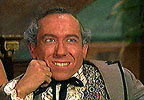 In medieval times boy-size men became the confidants of kings. Others distinguished themselves as vest-pocket James Bonds. One made Prime Minister of Denmark. In ancient Rome they were in such demand that Fagin’s stole children and stunted them by anointing their backbones with the grease of bats, moles and dormice. But in the 20th Century the little men were in eclipse till "Mister Michael" came along. That's what the children in Stanley Kramer's Columbia production, "Ship of Fools," call Michael Dunn, a 3-foot-10, 76-pound dramatic actor at whom nobody laughs when he says that some day he'll play "Richard III."
In medieval times boy-size men became the confidants of kings. Others distinguished themselves as vest-pocket James Bonds. One made Prime Minister of Denmark. In ancient Rome they were in such demand that Fagin’s stole children and stunted them by anointing their backbones with the grease of bats, moles and dormice. But in the 20th Century the little men were in eclipse till "Mister Michael" came along. That's what the children in Stanley Kramer's Columbia production, "Ship of Fools," call Michael Dunn, a 3-foot-10, 76-pound dramatic actor at whom nobody laughs when he says that some day he'll play "Richard III."
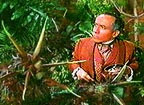 In "Ship of Fools," adapted from the Katherine Anne Porter best-selling novel, he is no mere foil, but in the role of Glocken, the sharp-eyed wise man, is practically the "Greek chorus" of the whole thing, and has one of the 11 star billings in Hollywood's most distinguished international cast of the year, along with Vivien Leigh, Simone Signoret, Jose Ferrer, Lee Marvin, Oskar Werner, Elizabeth Ashley, George Segal, Jose Greco, Charles Korvin, and Heinz Ruhmann.
In "Ship of Fools," adapted from the Katherine Anne Porter best-selling novel, he is no mere foil, but in the role of Glocken, the sharp-eyed wise man, is practically the "Greek chorus" of the whole thing, and has one of the 11 star billings in Hollywood's most distinguished international cast of the year, along with Vivien Leigh, Simone Signoret, Jose Ferrer, Lee Marvin, Oskar Werner, Elizabeth Ashley, George Segal, Jose Greco, Charles Korvin, and Heinz Ruhmann.
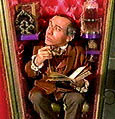 Out again, he went to the Florida University as a major in political science, earned a scholarship and took the journalistic prize in competition with every other college magazine editor in the land.
Out again, he went to the Florida University as a major in political science, earned a scholarship and took the journalistic prize in competition with every other college magazine editor in the land.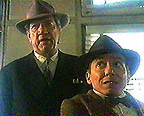 Philip Barry's "Here Come the Clowns," and Michel de Ghelderode's little modern classic, "Hop, Signore," before his big break on the Main Stem.
Philip Barry's "Here Come the Clowns," and Michel de Ghelderode's little modern classic, "Hop, Signore," before his big break on the Main Stem.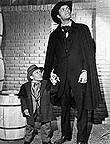 there are many possible roles, mostly symbolizing Sex or Death. He believes he could play Caliban, too, and, if it's ever dramatized, wants to do the lead in Par Lagerkvist's "The Dwarf."
there are many possible roles, mostly symbolizing Sex or Death. He believes he could play Caliban, too, and, if it's ever dramatized, wants to do the lead in Par Lagerkvist's "The Dwarf."